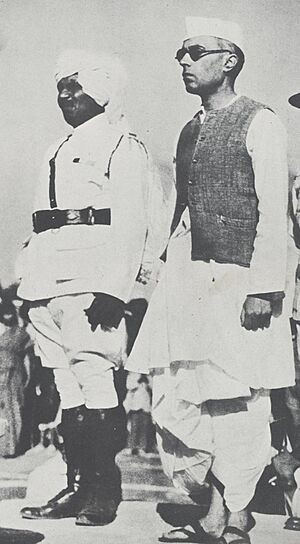Sampurnanand facts for kids
Quick facts for kids
Sampurnanand
|
|
|---|---|
|
संपूर्णानंद
|
|

Sampurnanand in 1936
|
|
| 2nd Governor of Rajasthan | |
| In office 16 April 1962 – 16 April 1967 |
|
| Chief Minister | Mohan Lal Sukhadia |
| Preceded by | Gurumukh Nihal Singh |
| Succeeded by | Sardar Hukam Singh |
| 2nd Chief Minister of Uttar Pradesh | |
| In office 28 December 1954 – 7 December 1960 |
|
| Preceded by | Govind Ballabh Pant |
| Succeeded by | Chandra Bhanu Gupta |
| Personal details | |
| Born | 1 January 1891 Benares, Benares State, British India |
| Died | 10 January 1969 (aged 78) Varanasi, Uttar Pradesh, India |
| Political party | Indian National Congress |
Sampurnanand (born January 1, 1891 – died January 10, 1969) was an important Indian teacher and politician. He served as the second Chief Minister of Uttar Pradesh from 1954 to 1960. Later, he became the Governor of Rajasthan. His time as Chief Minister of Uttar Pradesh lasted almost six years. This was the longest single term until Yogi Adityanath served even longer in 2023.
Sampurnanand was born in Varanasi. He was a very respected expert in Sanskrit and astronomy. During the movement for India's freedom, he took part in the Non-cooperation movement. He also worked as an editor for Maryada, a Hindi newspaper. He often wrote for the National Herald newspaper too.
His political journey started in 1922 when he joined the All-India Congress Committee. He was then made the Minister for Education in Uttar Pradesh. After India became independent, Sampurnanand was chosen for the Uttar Pradesh Legislative Assembly. He continued as the Education Minister. During this time, he planned to build an astronomy observatory. This observatory was at the Government Sanskrit College (GSC) in Varanasi. In 1974, the college was named Sampurnanand Sanskrit Vishwavidyalaya in his honor.
Sampurnanand became Chief Minister of Uttar Pradesh in 1954. He served for nearly six years. He stepped down after a political issue in the state government. As Chief Minister, he continued to support the use of the Hindi language. He also banned the killing of cattle, even though Prime Minister Jawaharlal Nehru did not agree. After leaving his role, he became the Governor of Rajasthan in 1962. There, he supported the "open prison" system. In this system, prisoners could live with their families and work outside.
Contents
Early Life and Education
Sampurnanand was born on January 1, 1891, in Benaras (now Varanasi). He came from a Kayastha family. He began his career as a teacher. He grew up with the traditional culture of Benaras. He strongly believed in old Indian traditions.
He was very interested in ancient Hindu culture. This included Sanskrit and Phalit Jyotish (astrology). His interest in astrology, combined with his love for learning, led him to study astronomy.
A Freedom Fighter's Journey
Sampurnanand was also a brave freedom fighter. People who were in jail with him during the freedom movement shared stories. They said he would discuss astronomy with them. He would also teach them about the night sky while they were in prison. He had a modern way of thinking too. This made him a mix of different ideas and influences.
Contributions as Education Minister
After India gained independence, Sampurnanand became the Education Minister. This was in the first elected government of Uttar Pradesh. This role helped him achieve his dream of promoting astronomy. He created plans to build an astronomical observatory. It also included a Time unit at the Government Sanskrit College (GSC) in Benaras. This college is now known as Sampurnanand Sanskrit University.
Dr. Sampurnanand was the first Chairman of the State Lalit Kala Akademi in U.P.. This academy was started on February 8, 1962. It was an independent body funded by the government.
Leading Uttar Pradesh
As Chief Minister, Sampurnanand strongly supported the Hindi language. He also pushed for a ban on cow slaughter. This shows his commitment to traditional values.
Reforms as Governor of Rajasthan
As the Governor of Rajasthan, he was a reformist. He promoted the idea of Sanganer’s "no-bars prison." In this special open prison, prisoners live with their families. They can go out to work and pay taxes for water and electricity. Sampurnanand believed that crime should not be about revenge. Instead, it should be about helping people change for the better. He thought that life imprisonment felt like a death sentence. This is because it separates people from their families and friends.
The Rajasthan government started the Sri Sampurnanand Khula Bandi Shivir (open jail). It was named after him. This experimental program began in 1963.


